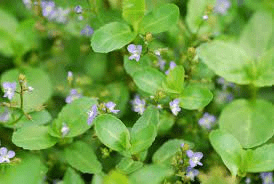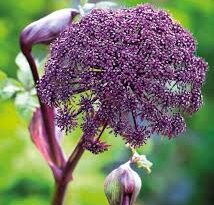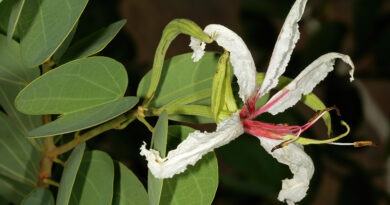17 Medicinal Health Benefits Of Brooklime (Veronica beccabunga)
Brooklime (Veronica beccabunga) is a perennial herbaceous plant belonging to the family Plantaginaceae. It is native to Europe, western Asia, and North Africa and is commonly found in wetland habitats, along the edges of ponds, streams, and other water bodies.
The plant is also known by various other names, including European Speedwell, Beckmeadow Speedwell, and Water Pimpernel.
Characterized by its trailing or creeping stems and vibrant green leaves, Brooklime forms dense mats that often float on the water’s surface or sprawl along the banks of water bodies. The leaves are opposite, toothed, and lance-shaped, while the small, light blue flowers have four petals and appear in clusters along the stems.
Brooklime has a long history of traditional use, dating back centuries. In herbal medicine, it has been utilized for its potential medicinal properties. The leaves are edible and have a mild, slightly peppery flavor. They were historically consumed as a salad green or cooked as a potherb.
Medicinally, Brooklime has been employed for its astringent and diuretic properties. It was believed to be beneficial for various conditions, including urinary tract issues and skin irritations. The plant contains compounds such as aucubin and tannins, which contribute to its potential therapeutic effects.
In addition to its traditional uses, Brooklime provides ecological benefits. Its dense growth along water bodies helps stabilize soil, prevent erosion, and create habitat for aquatic organisms. The plant also contributes to water quality by aiding in nutrient uptake and sediment filtration.
While Brooklime is not as widely used in contemporary herbalism as some other plants, its historical significance and potential medicinal properties continue to be recognized. As with any medicinal plant, it’s important to exercise caution and consult with a knowledgeable healthcare professional before using it for therapeutic purposes, especially considering potential variations in plant chemistry and individual health conditions.
The Botanical Description of Brooklime
1. Leaves: Brooklime, scientifically known as Veronica beccabunga, features lance-shaped leaves that are typically opposite and sessile. The leaves can vary in size but are generally smooth-edged and glossy.
2. Flowers: The plant produces small, attractive blue flowers with four petals. These flowers are arranged in clusters, adding to the aesthetic appeal of brooklime. The blooming period usually occurs in late spring to early summer.
3. Stems: Brooklime stems are often succulent and can root at the nodes when they come in contact with the soil. This characteristic contributes to the plant’s ability to spread and form dense mats.
4. Root System: The root system of brooklime is fibrous, aiding in its adaptation to aquatic environments. It allows the plant to anchor itself securely in wet or marshy areas.
5. Habitat: This perennial herb is well-adapted to wetlands, stream banks, and other moist habitats. Its preference for water-rich environments makes it a common sight near ponds, rivers, and ditches.
6. Growth Form: Brooklime exhibits a prostrate or creeping growth form. It tends to form extensive mats as it spreads horizontally, providing ground cover in its habitat.
7. Seed Characteristics: The plant produces small, capsule-like fruits containing numerous tiny seeds. These seeds facilitate the plant’s reproduction, allowing it to colonize new areas.
8. Foliage Color: The color of brooklime’s foliage can range from bright green to a deeper shade, depending on environmental conditions and sunlight exposure.
9. Adaptations: Brooklime has adaptations that enable it to thrive in aquatic environments, such as its succulent stems, fibrous roots, and ability to root at nodes. These adaptations contribute to its resilience in waterlogged habitats.
The Geographic Distribution of Brooklime
1. Europe: Brooklime is native to various parts of Europe, where it can be found in abundance along the banks of streams, rivers, and in damp meadows.
2. Asia: The plant has also established itself in parts of Asia, particularly in regions with similar wetland habitats.
3. North America: Brooklime has been introduced to North America and is now naturalized in certain areas, often near water bodies and marshy zones.
4. Australia: In Australia, brooklime can be found in localized regions, adapting to wet habitats and contributing to the biodiversity of aquatic ecosystems.
5. Africa: Although less common, brooklime has been identified in certain African regions, particularly in areas with a temperate climate and suitable water conditions.
6. South America: The plant has also been reported in South American countries, thriving in locations with adequate moisture and soil conditions.
7. Wetland Habitats: Brooklime’s geographic distribution is closely tied to its preference for wetland habitats, including riverbanks, pond edges, and marshy areas.
8. Invasive Behavior: In some regions, brooklime can exhibit invasive tendencies, outcompeting native vegetation and affecting local ecosystems.
The Chemical Composition of Brooklime
1. Iridoid Glycosides: Brooklime contains iridoid glycosides, compounds known for their anti-inflammatory and antioxidant properties.
2. Flavonoids: The plant is rich in flavonoids, which contribute to its medicinal properties and may have potential benefits for human health.
3. Triterpenoids: Brooklime’s chemical composition includes triterpenoids, compounds that are being studied for their pharmacological activities.
4. Phenolic Compounds: Phenolic compounds, with their antioxidant properties, are present in brooklime and contribute to its overall medicinal potential.
5. Alkaloids: Some varieties of brooklime may contain alkaloids, compounds that can have diverse effects on the human body.
6. Vitamins: The plant may contain vitamins, such as vitamin C, adding to its nutritional value and potential health benefits.
7. Minerals: Brooklime may accumulate essential minerals from its environment, enhancing its overall nutritional profile.
8. Essential Oils: Some species of brooklime may produce essential oils, contributing to the plant’s aroma and potential therapeutic uses.
9. Amino Acids: Brooklime may contain various amino acids, the building blocks of proteins, which are essential for various physiological functions.
10. Saponins: Saponins, known for their foaming properties, are found in brooklime and may have potential health implications.
11. Lignans: Certain varieties of brooklime may contain lignans, compounds that are being investigated for their antioxidant and anti-inflammatory properties.
12. Carotenoids: Brooklime may contain carotenoids, contributing to its coloration and potential antioxidant benefits.
Read Also: 18 Medicinal Health Benefits Of Ranunculus bulbosus (Bulbous Buttercup)
The Medicinal Health Benefits Of Brooklime (Veronica beccabunga)
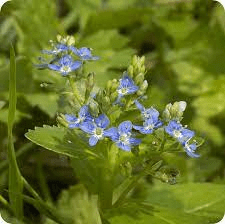
1. Anti-Inflammatory Properties: Brooklime has demonstrated anti-inflammatory effects, making it potentially beneficial for conditions involving inflammation.
2. Antioxidant Activity: The presence of flavonoids and other compounds imparts antioxidant properties to brooklime, which may help combat oxidative stress in the body.
3. Wound Healing: Traditional uses of brooklime include its application to wounds, as it is believed to have wound-healing properties.
4. Respiratory Health: The plant has been used in traditional medicine to address respiratory issues, and ongoing research explores its potential in this regard.
5. Digestive Aid: Brooklime may have digestive benefits, with compounds that could support gastrointestinal health.
6. Diuretic Effects: Some cultures have used brooklime as a diuretic, promoting the elimination of excess fluids from the body.
7. Skin Conditions: The plant is believed to have benefits for certain skin conditions, and topical applications are explored for dermatological purposes.
8. Detoxification: Brooklime’s diuretic properties contribute to its potential role in supporting detoxification processes in the body.
9. Anti-Rheumatic Effects: Traditional uses suggest that brooklime may have anti-rheumatic effects, potentially beneficial for joint health.
10. Cardiovascular Health: Ongoing studies investigate the impact of brooklime on cardiovascular health, with preliminary findings suggesting potential positive effects.
11. Urinary Tract Health: The diuretic nature of brooklime has led to its traditional use for promoting urinary tract health.
12. Antimicrobial Activity: Research indicates that brooklime may possess antimicrobial properties, which could contribute to its role in traditional medicine.
13. Anti-Cancer Potential: Some studies explore the potential anti-cancer properties of brooklime compounds, though more research is needed in this area.
14. Liver Support: Traditional uses include the use of brooklime to support liver function,with compounds that may have hepatoprotective effects.
15. Anti-Allergic Effects: Brooklime’s anti-inflammatory properties extend to potential anti-allergic effects, offering relief from certain allergic conditions.
16. Pain Relief: The plant has been traditionally used for pain relief, and ongoing research investigates its analgesic properties.
17. Antiviral Properties: Preliminary studies suggest that brooklime may have antiviral effects, showing promise in certain viral infections.
The Methods of Usage to Achieve the Provided Health Benefits Of Brooklime (Veronica beccabunga)
1. Herbal Infusions: Prepare herbal infusions by steeping brooklime leaves in hot water. This method can enhance respiratory and digestive health.
2. Topical Applications: Create poultices or ointments with brooklime for topical application on wounds and skin conditions, leveraging its potential wound-healing and dermatological benefits.
3. Incorporate in Salads: The leaves of brooklime, being edible, can be incorporated into salads, providing a flavorful and nutritious addition.
4. Decoctions: Boil brooklime roots to create decoctions that may have diuretic effects, promoting urinary tract health and supporting detoxification.
5. Tinctures: Tinctures can be made using brooklime, offering a concentrated form for medicinal use. Proper dosage is essential when using tinctures.
6. Steam Inhalation: Inhaling steam infused with brooklime extracts can be beneficial for respiratory health, particularly in addressing congestion and inflammation.
7. Capsules or Tablets: For those who prefer a more convenient form, brooklime extracts can be encapsulated or compressed into tablets for oral consumption.
8. Herbal Teas: Brew herbal teas using brooklime leaves, providing a soothing and health-promoting beverage that can be consumed regularly.
9. Oil Infusions: Extract essential oils from brooklime for use in aromatherapy or as a topical application, harnessing its aromatic and potential therapeutic properties.
10. Compresses: Apply brooklime-infused compresses to areas of pain or inflammation, utilizing its potential analgesic and anti-inflammatory effects.
The Side Effects Of Using Brooklime Medicinal Plant
1. Allergic Reactions: Some individuals may experience allergic reactions to brooklime. Monitor for symptoms such as itching, redness, or swelling.
2. Digestive Discomfort: Ingesting large amounts of brooklime may cause digestive discomfort, including nausea or upset stomach.
3. Photosensitivity: Certain compounds in brooklime may increase sensitivity to sunlight. Users should take precautions to avoid excessive sun exposure.
4. Drug Interactions: Individuals taking medications should consult with a healthcare professional, as brooklime may interact with certain drugs.
5. Pregnancy and Breastfeeding: Pregnant and breastfeeding individuals should exercise caution, as the safety of brooklime during these periods is not well-established.
6. Excessive Diuresis: The diuretic effects of brooklime may lead to excessive fluid loss, potentially causing dehydration.
7. Gastrointestinal Irritation: In some cases, brooklime may cause irritation to the gastrointestinal tract, leading to discomfort.
8. Liver Health: Individuals with existing liver conditions should use brooklime cautiously, as its impact on liver health is not fully understood.
9. Central Nervous System Effects: Some users may experience mild central nervous system effects, such as dizziness or headache.
10. Blood Pressure: Brooklime’s potential impact on blood pressure should be considered by individuals with hypertension.
11. Renal Function: Due to its diuretic properties, brooklime may affect renal function, and those with kidney issues should use it with caution.
12. Skin Sensitivity: Topical applications of brooklime may cause skin sensitivity in some individuals. A patch test is recommended.
13. Prolonged Use: Prolonged and excessive use of brooklime may lead to unforeseen health effects. Users should adhere to recommended dosages.
Read Also: 16 Medicinal Health Benefits Of Asafoetida (Ferula assa-foetida)
The Scientific Research and Studies of Brooklime
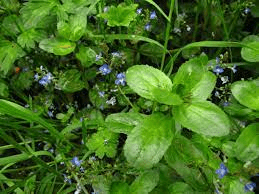
1. Anti-Inflammatory Studies: Scientific investigations have explored brooklime’s anti-inflammatory properties, identifying potential mechanisms and applications.
2. Pharmacological Research: Studies on the pharmacological activities of triterpenoids in brooklime have shown promising results, with implications for drug development.
3. Flavonoid Research: The antioxidant and anti-inflammatory effects of flavonoids in brooklime have been a subject of scientific interest, contributing to its medicinal potential.
4. Clinical Trials: Ongoing clinical trials assess the efficacy of brooklime extracts in addressing specific health conditions, providing valuable insights.
5. Biochemical Studies: Researchers have conducted biochemical studies to unravel the chemical composition of brooklime, shedding light on its potential health benefits.
6. Toxicology Investigations: Toxicological studies aim to evaluate the safety profile of brooklime, providing essential information for regulatory purposes.
7. Antimicrobial Properties: Scientific exploration into brooklime’s antimicrobial properties has identified its potential in combating various microorganisms.
8. Cancer Research: Preliminary research investigates the potential anti-cancer properties of brooklime compounds, opening avenues for further exploration.
9. Respiratory Health: Studies focusing on brooklime’s impact on respiratory health aim to elucidate its effectiveness in addressing respiratory conditions.
10. Cardiovascular Studies: Ongoing research explores the cardiovascular effects of brooklime, assessing its potential role in promoting heart health.
11. Amino Acid Analysis: Scientific analyses delve into the amino acid composition of brooklime, unraveling its nutritional profile and physiological implications.
The Safety Precautions and Recommendations In Using Brooklime Medicinal Plant
1. Consultation with Healthcare Professionals: Individuals with pre-existing health conditions or those on medication should consult healthcare professionals before using brooklime.
2. Dosage Guidelines: Adhere to recommended dosage guidelines to avoid potential side effects and ensure the safe use of brooklime.
3. Pregnancy and Breastfeeding: Pregnant and breastfeeding individuals should seek advice from healthcare providers before incorporating brooklime into their regimen.
4. Monitoring for Allergic Reactions: Users should monitor for any signs of allergic reactions and discontinue use if symptoms occur.
5. Sun Protection: Due to potential photosensitivity, users should take adequate sun protection measures when using brooklime.
6. Hydration: Maintain adequate hydration, especially when using brooklime for its diuretic effects, to prevent dehydration.
7. Regular Health Check-ups: Regular health check-ups are advisable for individuals using brooklime regularly, especially those with underlying health issues.
8. Cautious Use in Children: Exercise caution when considering the
use of brooklime in children, as the safety and appropriate dosage for this demographic may not be well-established.
9. Avoid Prolonged Use: Long-term and excessive use of brooklime should be avoided to prevent potential adverse effects. Users should adhere to recommended durations.
10. Monitoring Blood Pressure: Individuals with hypertension should monitor their blood pressure regularly when using brooklime, as it may influence cardiovascular parameters.
11. Liver Function Tests: Those with existing liver conditions should consider periodic liver function tests when incorporating brooklime into their wellness routine.
12. Kidney Function Monitoring: Due to its diuretic nature, brooklime may impact kidney function. Individuals with kidney issues should monitor renal function closely.
FAQs About Brooklime Medicinal Plant
1. Life: Is Brooklime Safe for Long-Term Use?
Brooklime is generally considered safe for short-term use, but long-term and excessive consumption may lead to unforeseen health effects. It’s advisable to follow recommended guidelines and consult with a healthcare professional.
2. Health Benefits: Can Brooklime Help with Digestive Issues?
Yes, brooklime has been traditionally used for digestive benefits. Its compounds may support gastrointestinal health, but users should be mindful of dosage to avoid potential digestive discomfort.
3. Dosage: What Is the Recommended Dosage for Brooklime Supplements?
The recommended dosage of brooklime supplements can vary. It’s crucial to follow product-specific guidelines or consult with a healthcare professional for personalized advice.
4. Interactions: Does Brooklime Interact with Medications?
Brooklime may interact with certain medications. Individuals on prescription drugs should consult with their healthcare provider to ensure safe co-administration and prevent potential interactions.
5. Skin Sensitivity: Can Brooklime Cause Skin Sensitivity?
Some individuals may experience skin sensitivity with topical applications of brooklime. Conduct a patch test before widespread use and discontinue if irritation occurs.
6. Pregnancy: Is Brooklime Safe to Use During Pregnancy?
Pregnant individuals should exercise caution, as the safety of brooklime during pregnancy is not well-established. Consultation with a healthcare professional is recommended before use.
7. Culinary Use: Can Brooklime Leaves Be Consumed in Salads?
Yes, the leaves of brooklime are edible and can be incorporated into salads, providing a nutritious and flavorful addition to culinary dishes.
8. Children: Is Brooklime Safe for Children?
The safety of brooklime in children is not well-documented. Parents and caregivers should exercise caution and seek guidance from healthcare professionals before administering brooklime to children.
9. Photosensitivity: How Can Users Protect Themselves from Brooklime-Induced Photosensitivity?
Users can protect themselves by applying sunscreen, wearing protective clothing, and limiting sun exposure when using brooklime, especially if they are prone to photosensitivity.
10. Allergies: Are Allergic Reactions Common with Brooklime?
While allergic reactions are not common, some individuals may be sensitive to brooklime. Monitoring for symptoms such as itching or swelling is advisable, and use should be discontinued if any adverse reactions occur.
11. Liver Health: Can Brooklime Affect Liver Function?
Individuals with existing liver conditions should use brooklime cautiously, as its impact on liver health is not fully understood. Regular monitoring and consultation with a healthcare professional are recommended.
12. Blood Pressure: Should Individuals with Hypertension Avoid Brooklime?
Individuals with hypertension should monitor their blood pressure regularly when using brooklime, as it may influence cardiovascular parameters. Consulting with a healthcare professional is advisable.
13. Respiratory Health: How Can Brooklime Be Used for Respiratory Health?
Brooklime can be used for respiratory health through methods such as steam inhalation or herbal teas. However, users should follow recommended guidelines and consult with healthcare professionals if needed.
14. Storage: How Should Brooklime Supplements be Stored?
Brooklime supplements should be stored in a cool, dry place, away from direct sunlight. Following the storage instructions on the product label is essential to maintain their efficacy.
15. Contraindications: Are There Any Contraindications for Brooklime Use?
Individuals with known allergies to the plant or its components should avoid brooklime. Additionally, those with specific medical conditions or on certain medications should seek guidance from healthcare professionals before use.
16. Topical Application: Can Brooklime Ointments be Used for Various Skin Conditions?
Yes, brooklime ointments are traditionally used for skin conditions. However, individual responses may vary, and users should discontinue use if adverse reactions occur.
17. Regulatory Status: Is Brooklime Regulated by Health Authorities?
The regulatory status of brooklime may vary by region. Users should ensure that any supplements or products comply with local health regulations and standards.
Read Also: A Comprehensive Overview of America’s Waste Disposal

